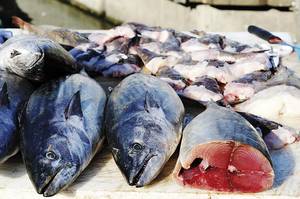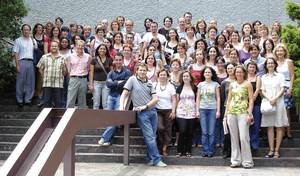Invisible pollution to light

The INMA project has 550 Gipuzkoan families. They started in 2006. At that time, data collection began with 630 pregnant women who went to the hospital in Zumarraga and continue with children born of them. They record the data of the child and his environment and compare them with those recorded in other Spanish groups. They measure mercury levels: in the blood and diet of children. The objective is to investigate whether certain environmental compounds affect the child's development.
Hence, for example, last year's recommendation not to consume large fish such as red tuna. The reason is that the methyl mercury present in water accumulates especially in large quantities in the tissues of these fish, being at the end of the trophic chain, and is harmful to the development of the fetus and young children.
These types of recommendations are unusual. They affect the economic sectors and are decisions that must be taken with great care from the socioeconomic point of view, but they are necessary because there is health at stake. To bring the issue to light and spread clear guidelines through public institutions, they have to do rigorous studies.
Ancient known known as the Ancient
The toxic character of methylmercury has long been known. One can take as an example the tragedy after a spill on the island of Minamata, in Japan, in the 1950s, or the disorders in the development of unusual children. The fact that so far they have not been used as a model has an explanation: The inhabitants of Minamata accumulated large amounts of methyl mercury in the body, while the Inuit, one of the main ingredients of their diet is the whale, which in addition to methyl mercury, absorb other harmful compounds.
So, why advise big fish in Spain? In many villages that eat a lot of fish these tips are not new. But in Spain the situation was not known. Within the INMA project, in the cohort or research group of Gipuzkoa and in Valencia, high levels of mercury have been detected, and given the follow-up of the diet of these women, the conclusion has been clear: this high level of mercury is associated with the consumption of large fish.

Zilborrest blood tests were performed, and according to the data obtained, 64.7% of newborns contained more than 6.4 micrograms of mercury per liter of blood, above the safe level (5.8 micrograms per liter) for neurodegeneration according to the EPA (United States Environmental Protection Agency; Enviromental Protection Agency).
The INMA project is ambitious and is very broad considering the number of mothers, children and experts involved and the amount of studies. If it is not possible to reach such clear conclusions. Jesús Mari Ibarluzea, coordinator of the Gipuzkoan cohort, pointed out that the objective is to answer the following question: "Does the level of pollutants we now have affect the physical and psychological development of children? ", since large quantities are used in laboratory tests to measure the toxicity of compounds, but what really interests us is to know if they are harmful in the usual amount. To do this, instead of taking laboratory experiments, samples should be taken from real life, that is, from the people and the environment in which they live.
Collection and collection of data
Many diseases are multifactorial, that is, they are related to more than one factor, many times interacting, so it is difficult to know the causal effect. Therefore, to ensure that a certain compound has negative effects, it is necessary to take into account the greatest number of factors, the measurable factors. In this case, it is also a question of milder alterations than diseases.
In the INMA project they investigate the influence of compounds from three sources mainly: air, water and diet. And they also take into account less specific sources like the usual household cleaning products, insecticides, cosmetics... They perform the chemical analyses corresponding to each source to know the presence of the compounds. On the other hand, they check if these compounds reach the human organism: they take samples to pregnant women of blood, hair, urine, saliva... and also children. At birth, they receive the placenta and umbilical cord, as well as samples of the orchard and breast milk, and evaluate through tests the psychological and cognitive development as the child grows.

Since the objective is to investigate the influence of contaminating compounds on the development of the child, they also study the social factors that influence the development of the child, such as the family environment, the stimuli that the child receives, etc. Thus, they take into account all known factors related to the development of the child to correctly apply the cause-effect principle.
Attention organochlorinated
According to Jesus Mari Ibarluze, "food is the main source of contaminating compounds in most cases; the most important for us are mercury and PCBs." PCBs, polychlorinated biphenyls, are part of a wide and varied group of organochlorate compounds.
The PCBs were produced in large quantities in the industry until their ban in 1979. Until then, in the industry they were used perfectly as insulator of cables and electrical systems, among other things, to give plastic character to paints and rubber. PCBs have the right characteristics for it: they are not flammable, have a high boiling point and are electrical insulators. In addition, they are chemically very stable and this feature was exceptional for applications, but it is also the cause of the problems it has generated. And it is that, despite having spent years since they were banned, they have not disappeared from the environment and are accumulated in the human organism. From generation to generation they bioaccumulate, which, being liposoluble, are dissolved in the fats of the organism. It is especially harmful to the developing fetus and reaches him from his mother through the placenta.
Nerea Lertxundi, professor of the UPV-EHU and neuropsychologist, works on the elaboration of the thesis on the effects of organochlorine compounds on the neuropsychological development of the child within the framework of the INMA project, which has already seen its effects: "The amounts we currently have are not tremendous, we have to make it clear, but our results indicate that negative influences can be seen in the cognitive and psychomotor development of children. When analyzing these results, it should be made clear that the children studied show the expected development of their age and that the influence of these compounds, at clinical level, is not observable at all. The interpretation of the results does not make sense on an individual level but on a collective level. Therefore, from these results it is deduced that these compounds have a subclinical negative effect that has implications to be considered in the field of Public Health".
Lertxundi works with the children of the Zumarraga hospital team from Goierri and Urola Medio and Garai. In his opinion, participation is especially significant: "The gynecologist offered all the women who did the first ultrasound the possibility of participating in this project, and 70% said yes. Participation is very high, in other cohorts usually around 50%".
The Zumarraga Hospital was chosen for the need to locate all studies in a single area, but Jesús Mari Ibarlucea considers that "it is an area of very interesting influence, since it is a question of coffers with an industry rooted and of great traffic". Therefore, the studies of diet and air are priority in the cohort of Gipuzkoa. "For other research on the INMA project, our cohort makes a bridge," says Ibarluzea, "in terms of the investigation of contaminants in the water, which here are very low, because the water is of very good quality."
They share the data collected in the seven cohorts participating in the project, but not just that. The amount of information accumulated is such that it is made available to external researchers to the project so that they can also be useful in studies of another level.
According to those responsible for the project, no signs of alarm have been found, although it is known that there are compounds that are a source of pollution in the air, food and water to a greater or lesser extent. The reason for concern for the moment should be ignorance, since we do not know the impact of many of these compounds on human health and, much less, on children and children.
Buletina
Bidali zure helbide elektronikoa eta jaso asteroko buletina zure sarrera-ontzian












